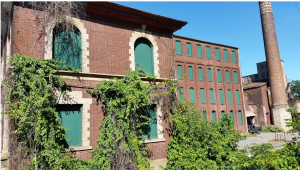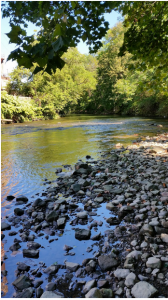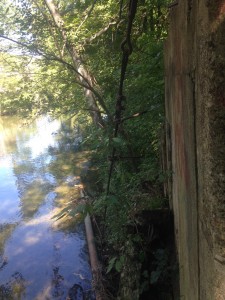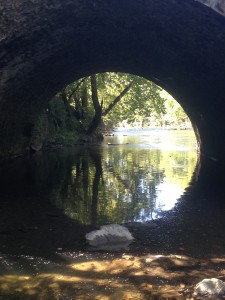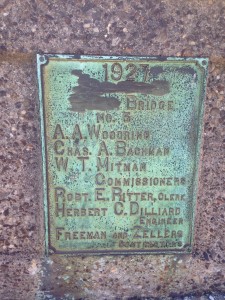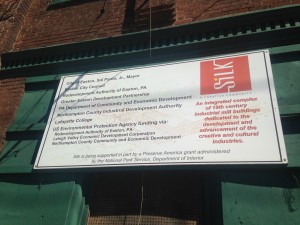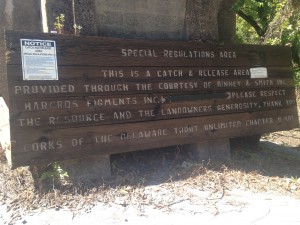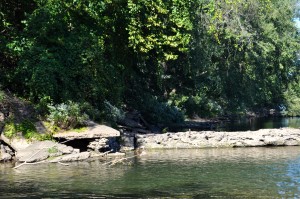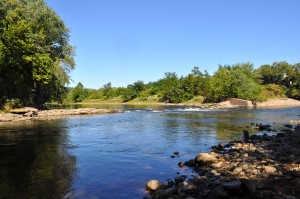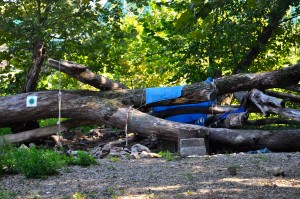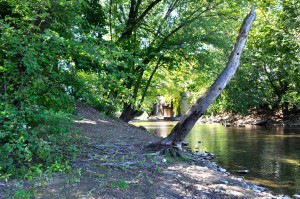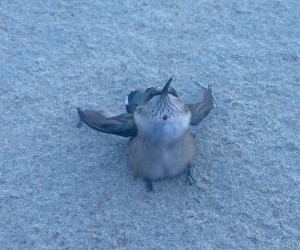By Alexa Gatti and Nicole Maksymiw
Today, we explored the Simon Silk Mill site from multiple perspectives. We began in the parking lot at the end of the Karl Stirner Arts Trail and found a run-down pathway leading toward the creek. We sat on an exposed bed of rocks deposited on the edge of the creek. It was clear that this area is submerged in water at times of greater water flow. We wondered how flooding issues may have impacted the location and the mill. Did the force of water cause operational hazards or contribute to the eventual closing of the mill? The rocks around us were damp, so it seems that the force and amount of water in the creek varies regularly and affects the rocks and other features of this area. The rocks in this area were smooth and rounded, mostly of a larger size. This part of the creek was well shaded during the mid-afternoon. The creek appears quite clear and shallow, since the sun shines through the water to the pebbly bottom. Moving at a steady pace, the water movement around the shallow rocks creates many riffles in the creek. The sounds of this area are a mixture of water rushing past these riffles and traffic rushing past in the road.
To our left was a bridge that connected the arts trail side of the road to the silk mill side. Behind us, there was a built stone wall along the arts trail. The brick silk mill was across from us. The windows closed with green-painted wood, looking as if it were still in fairly good condition. on the left side of the mill’s face there is a path of plants sprawling upwards. We wondered how this area may be impacted by invasive species. To the right, the mill looked more decrepit. The glass of the windows were shattered. One large smoke stack stood at the right-hand side of the building. What was emitted from this stack? Water vapor or pollutants? This made us wonder what processes and resources are required to produce silk. Is water a major component of production and, if so, how was the creek impacted by this? We imagined workers coming out to the creek for lunch and commuting to the mill. Who were the workers and what were conditions like in the mill? A little ways down the creek we saw a mysterious structure protruding from the stone wall. We contemplated whether we’d be able to wade to that spot, but opted to hold off. (Nicole was wearing a dress and Alexa had Spanish class in an hour.) We did approach the mysterious contraption from above before returning to the car. We must investigate what it could be but it seems that it would have connected to the mill. Large rusted cables were strung from a thick metal beam. Attached to the cables was a long rusted metal pillar lying horizontally in the water. What purpose did this feature serve? We have not yet investigated the history of the mill so we are eager to piece together a clearer picture of the past.
After wandering in this spot down by the creek, we decided to explore the surrounding area more. We found a “Catch and Release Area” across the road, so there must be a fair amount of recreational fishing just up the creek. A sign on the side of the old silk mill recognized it as Silk: A Creative Community. Silk is an initiative “dedicated to the development and advancement of the creative and cultural industries.” There is also evidence of ongoing construction within the mill. This is a project we will explore further in research.
While walking alongside the mill, we noticed a contrast in design and building materials between the creek side and the far side of the building. The creek side has newer brick patterns, a modern concrete frame of the windows, smoother window boards, and a newer chimney than the circular metal ones on the other section of the building. We look forward to exploring the timeline of development in this location.

